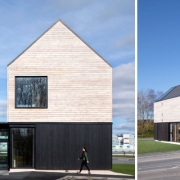Sarah Kostense-Winterton, Executive Director | Mineral Wool Insulation Manufacturers Association
British homeowners hold the key to decarbonising our homes. We must motivate them to take action now.
“It is fact that homes and buildings in the UK account for over 22% of carbon emissions. Homeowners comprise the largest housing tenure at around 64% of the UK’s 28 million households and therefore the largest potential market for financing home decarbonisation. This sector is crying out for significant new investment from the Government and the scale of this investment will determine whether we eventually cross the Net Zero finish line or not.”
Supporting a Sustainable Supply Chain
Firstly, there are no silver bullets. However, it is clear that a long-term policy and investment approach is needed to provide certainty for industry. Only such an approach will provide businesses with the confidence to make substantial, sustained investments in skills and supply chains, driving innovation and lowering the costs of technologies and installations in key markets.
In this context, Government should consider the full suite of financial support, incentives and levers to trigger behavioural change and give homeowners the full support they need to upgrade their homes and get the UK on track for 2030 carbon targets and beyond. While support has been pledged for fuel poor and low-income households, many homes will slip through the net. Millions of households are classed as “able to pay”, but the reality is that many are not in a position to afford deep home retrofits, nor incentivised to do so.
Levelling Up and Job Creation
The most recent English Housing Survey found that 33% of homeowners have no savings and those with the lowest levels of savings and wealth – and least energy efficient homes – live disproportionately in the North of England and the Midlands. These are the regions which most benefit from grant funding, supporting the levelling-up agenda. Overall, an energy efficiency investment programme to 2030 can create 190,000 jobs nationally, drive billions of pounds of private investment, and deliver energy bill savings worth £7.5 billion.
Policy and Funding Gap
The abrupt closure of the Green Homes Grant, has left a gaping funding and policy void in the so called ‘able-to-pay’ market, and there is now a clear need for support including well-known structural incentives, such as Green Stamp Duty and 0% VAT for green home retrofits.
As shown in the UKGBC’s new report “A housing market catalyst to drive carbon emission reductions Low energy adjustment to Stamp Duty Land Tax” even a modest adjustment to Stamp Duty Land Tax would build a thriving retrofit market, supporting green jobs, boosting household spending and bringing down fuel bills. Embedding building energy performance into the homebuying decision-making process, it could catalyse and drive the market to deliver both energy efficiency improvements and low carbon heat and power. The policy has the potential to be both revenue neutral and drive demand for energy efficiency and low-carbon heating measures, improving Energy Performance Certificate ratings as a result.
it will not be possible for the Government to meet its long-term net zero target without substantially scaling action and investment for British homeowners
Government’s Next Steps
The forthcoming Heat and Buildings Strategy provides the policy opportunity and must set out the Government’s vision and roadmap for the UK to rapidly decarbonise homes across the country, through new targets, regulation and strategies for each tenure. To achieve widespread uptake of low carbon heating technologies and energy efficiency measures combined, financial institutions, the construction industry, local government, owner-occupiers, landlords and tenants must be motivated to take coordinated action.
The 2021 Spending Review and Budget provides the funding opportunity to get us back on track. Treasury must back a long-term package that spurs action and investment from homeowners – many of whom will not have the disposal income or savings to pay for the upgrades their homes need. Also, as new regulations are expected to come into place, such as a phase out of fossil gas boilers and minimum energy efficiency standards for owner-occupier homes, it is vital that there is support in place for all households through this transition.
Major Benefits
Finally, an energy efficiency infrastructure investment programme to 2030 would deliver major benefits across Britain, boosting productivity and supporting the levelling-up agenda. A sustained drive to boost home energy efficiency can reduce household energy expenditure by £7.5 billion per year, support hundreds of thousands of jobs across a range of trades, and reduce pressure on the NHS created by fuel poverty and cold, unhealthy homes – potentially preventing 10,000 excess winter deaths every year and saving the NHS £1.4 to £2 billion annually.
A public investment, fiscal and financial package to 2030 will unlock billions in existing capital and private investment, supported by innovation and the growth of new markets for green financial products and services. Few infrastructure projects can do so much for economic growth: with £2 put back in economy for every £1 spent on a national retrofit strategy.
However, one thing we are sure of right now – at present, policies and investment plans fall far short of what is needed to decarbonise homes to the levels required by carbon budgets and the Government’s own energy performance targets. As stressed by the Climate Change Committee, it will not be possible for the Government to meet its long-term net zero target without substantially scaling action and investment for British homeowners.
Sarah Kostense-Winterton is Executive Director at the Mineral Wool Insulation Manufacturers Association (MIMA) the UK’s industry trade body
for non-combustible, breathable glass and stone wool insulation, representing the leading mineral wool insulation companies in the UK.
She is also Co-Founder and Chairman of the Energy Efficiency Infrastructure Group (EEIG) – a broad-based coalition of over 25 industry groups,
NGOs, charities and businesses asking for rapid improvement in energy efficiency policy for UK homes and buildings.













